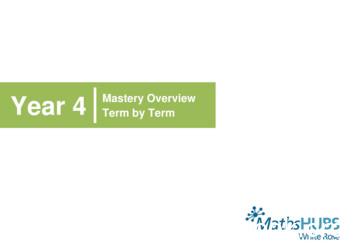My Dearest Watercolourists, This Week As I Promised We Are Going To .
My dearest watercolourists,I hope you’re well.This week as I promised we are going to look at how to create perspective. Wehave often heard or spoken about the vanishing point and perspective. However,we have not properly looked at how to create an environment governed by this.This is what our session today is going to be about. I have attached a couple ofold masters’ paintings for reference.Church. Interior of a Gothic Church. Copper, c1615, by Hendrik van SteenwyckII and Jan Brueghel I.
Johann Ludwig Ernst Morgenstern, A Church InteriorThis is the extent to which one can take this technique!What we are going to do is apply the same principles, but we are going to startsmall.First things first we’re going to use a landscape-oriented paper.We are going to trace the vertical symmetry line exactly down the middle. I dosuggest you use a ruler.Then we are going to trace the line of the horizon – the line at which our eyescan see straight ahead.We are creating an interior of a room, so this line is going to be approximativelythe height of a person in relation to the room. The eye-line can be about 1/3 or1/4 to the top of the paper.
Next we are going to add the floor which is going to be one line parallel to theedge of the paper.
And we’re also going to add another line that’s going to be the edge betweenthe ceiling and the wall that we see in front of our eyes. The back wall isparallel to us. So its corner will always have 90-degree angles.We are next going to add the left and the right walls.As I mentioned, the back wall is in a plane that is parallel to us (the viewpoint).So, to define the wall, we need to add two vertical lines to connect the top andbottom horizontal lines. These lines, of course, are parallel to the left and theright edge of the paper. The back wall is a simple rectangle.Now, the more difficult part, or at least, it’s a little bit more difficult to wrapyour head around in the beginning, is how to create the diagonal lines at theintersection of the left or the right wall and the floor or the ceiling.This is where the vanishing point becomes essential. We’re going to place oneend of our ruler to the vanishing point and connect the corner of the innerrectangle. we will elongate the line to the outside of the paper and repeat it onthe other side.
Because the vanishing point is not exactly in the very middle of the page, theceiling lines and their angles are going to look different from the ones from thefloor.
We use exactly the same principle with a ruler connecting the top corner of thewall to the vanishing point.We’re going to repeat on the right.The vanishing point will remain the reference point. All the lines and objects weintroduce will be in relation to this point. The idea is that if we were to elongateany lines (from any object in the room), they would all meet and connect at thisvanishing point.Here are some examples
An easy application of this vanishing point and use of perspective to createdepth is making a wooden floor. All we have to do is connect the vanishingpoint to the edge of the floor, elongate those lines and then move the ruler 1 cmto the left (or right, I started from the right to the left but there is no correctway). This way we obtain lines that follow the perspective until one line in themiddle is perfectly vertical. The angles change, and we perceive this as depth.Now that we have the floor ready, we can continue to introduce some otherelements into our composition. For example, we can start adding somefurniture!We add a chest of drawers, first, and we choose where we want it to be and howtall we want it. As the back wall and the horizon are in relation to humanheight, roughly estimate how tall you want this chest of drawers to be. Add adot on the wall to suggest the height. Then use the vanishing point and a ruler,connect the vanishing point and this dot and draw a line on the wall- this will bethe back edge of the chest of drawers. Next, use a horizontal line coming out ofthe back end of the line drawn on the wall- this will be the depth of the top ofthe chest. Use the vanishing point again and add a line parallel to the back edgeof the chest of drawers and connect this line to the end of the horizontal line.That will be the top of your chest of drawers. Use the right back corner and anodd vertical line going down to the floor. And then use the left corner of the
vertical line going all the way into the floor. Keep in mind that the object maybe a little bit bigger so you may not be able to see it whole, just as in theexample here, where, for me, the bottom left corner of the object is outside theview.You can also add something like a painting on the wall. This is easy. Thevertical lines are simple. Trace two vertical lines and connect these togetherwith two lines using the vanishing point.I also added a window. As the back wall in in a plane parallel to us, the cornersare 90 degrees.We continued to apply the exact technique to introduce other objects. What wedid here were a bed, a bookshelf, and a bedside table.The way we introduced the bed is quite similar to the chest of drawers. Westarted with the dot on the right wall near the corner of the room- suggesting theappropriate height. Then we elongated the dot to the edge of the paper using thevanishing point. This is the right edge of the bed. Then we add a horizontal lineon the back wall- the back edge of the bed- the depth. We then elongate the leftend of this line using the vanishing point to add the left edge of the bed. Thelegs are vertical lines.
From there, we freestyled the rest of the elements such as the headrest, all thelegs as well as the bedding. We use the same principle to add a little table. Makesure that, as you’re adding the bedside table, you draw the front legs bigger andlonger than the back ones- the closer features appear wider and taller inperspective drawing.
We also added a bookshelf, again using the vanishing point in the line on theright sidewall. We decorated a bookshelf with some books, of course, and wealso added a little plant!Because our composition has been governed by straight lines and most of themhave harsh corners, we decided to soften it up a little with a couple of curvedlines. we added a lamp, a painting that was oval-shaped, a landscape through thewindow, and we also added some beds and curtains. Finally, it was time topaint!I will let you be creative with your painting application, but I will leave my finalpainting here for reference!I hope you enjoyed this! Please let me know your thoughtsKindest regards,Ioana
What we are going to do is apply the same principles, but we are going to start small. First things first we're going to use a landscape-oriented paper. We are going to trace the vertical symmetry line exactly down the middle. I do suggest you use a ruler. Then we are going to trace the line of the horizon - the line at which our eyes
(prorated 13/week) week 1 & 2 156 week 3 130 week 4 117 week 5 104 week 6 91 week 7 78 week 8 65 week 9 52 week 10 39 week 11 26 week 12 13 17-WEEK SERIES* JOIN IN MEMBER PAYS (prorated 10.94/week) week 1 & 2 186.00 week 3 164.10 week 4 153.16 week 5 142.22 week 6 131.28 week 7 120.34
Week 3: Spotlight 21 Week 4 : Worksheet 22 Week 4: Spotlight 23 Week 5 : Worksheet 24 Week 5: Spotlight 25 Week 6 : Worksheet 26 Week 6: Spotlight 27 Week 7 : Worksheet 28 Week 7: Spotlight 29 Week 8 : Worksheet 30 Week 8: Spotlight 31 Week 9 : Worksheet 32 Week 9: Spotlight 33 Week 10 : Worksheet 34 Week 10: Spotlight 35 Week 11 : Worksheet 36 .
28 Solving and Graphing Inequalities 29 Function and Arrow Notation 8th Week 9th Week DECEMBER REVIEW TEST WEEK 7,8 and 9 10th Week OCTOBER 2nd Week 3rd Week REVIEW TEST WEEK 1,2 and 3 4th Week 5th Week NOVEMBER 6th Week REVIEW TEST WEEK 4,5 and 6 7th Week IMP 10TH GRADE MATH SCOPE AND SEQUENCE 1st Week
Year 4 negative numbers. digit numbers by one digit, integer Year Group Y4 Term Autumn Week 1 Week 2 Week 3 Week 4 Week 5 Week 6 Week 7 Week 8 Week 9 Week 10 Week 11 Week 12 Number – place value Count in multiples of 6, 7, 9. 25 and 1000. digits using the formal writt
WRM –Year 6 –Scheme of Learning 2.0s Week 1 Week 2 Week 3 Week 4 Week 5 Week 6 Week 7 Week 8 Week 9 Week 10 Week 11 Week 12 tumn Number: Place Value N
MMWR Week. Week 10: 3/29-4/4 3/1-3/7 Week 11: 3/8-3/14 Week 12: 3/15-3/21 Week 13: 3/22-3/28 Week 14: Week 15: 4/5-4/11 Week 16: 4/12-4/18 Week 17: 4/19-4/25 Week 18: 4/26-5/2 Week 19: 5/
Year 11 HSC Assessment Policy 2019 An information guide for parents and students. 2 Week 1 Week 2 Week 3 Week 4 Week 5 Week 6 Week 7 Week 8 Week 9 Week 10 Week 11 . Anc History English Studies Physics Std English Adv English Drama CAFS Std Maths Adv Maths Ext Maths Visual Arts PDHPE Dance
NORTH LANARKSHIRE COUNCIL AGmA REPORT 1 1 I I 1 1 IFROM: QR8FSocWWoRK PERlQD Ollff109 - 16mm I I SoClAtWoRK DATE : 16 SEPTEMBER1896 Ref. : EMch I I 1 1. introduction This report compares actual expenditure and income against estimates both for the year to date and the prc@cted &-turn. Explanations are provided for the major &-turn variance.





















